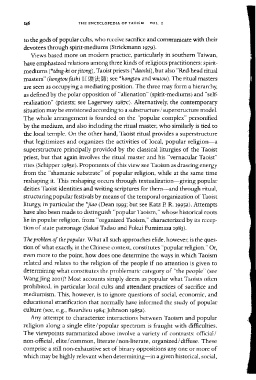Page 186 - The Encyclopedia of Taoism v1_A-L
P. 186
146 THE ENCYCLOPEDIA OF TAOISM VOL. I
to the gods of popular cults, who receive sacrifice and communicate with their
devotees through spirit-mediums (Strickmann 1979).
Views based more on modern practice, particularly in southern Taiwan,
have emphasized relations among three kinds of religious practitioners: spirit-
mediums (*tang-ki or jitong), Taoist priests (*daoshi), but also "Red-head ritual
masters" (hongtou fashi H ll1'i l! ~ili; see *hongtou and wutou). The ritual masters
are seen as occupying a mediating position. The three may form a hierarchy,
as defined by the polar opposition of "alienation" (spirit-mediums) and "self-
realization" (priests; see Lagerwey 1987C). Alternatively, the contemporary
situation may be envisioned according to a substructure / superstructure model.
The whole arrangement is founded on the "popular complex" personified
by the medium, and also including the ritual master, who similarly is tied to
the local temple. On the other hand, Taoist ritual provides a superstructure
that legitimizes and organizes the activities of local, popular religion-a
superstructure principally provided by the classical liturgies of the Taoist
priest, but that again involves the ritual master and his "vernacular Taoist"
rites (Schipper 1985e). Proponents of this view see Taoism as drawing energy
from the "shamanic substrate" of popular religion, while at the same time
reshaping it. This reshaping occurs through textualization-giving popular
deities Taoist identities and writing scriptures for them-and through ritual,
structuring popular festivals by means of the temporal organization of Taoist
liturgy, in particular the *jiao (Dean 1993; but see Katz P. R. 1995a). Attempts
have also been made to distinguish "popular Taoism," whose historical roots
lie in popular religion, from "organized Taoism," characterized by its recep-
tion of state patronage (Sakai Tadao and Fukui Fumimasa 1983).
The problem of the popular. What all such approaches elide, however, is the ques-
tion of what exactly, in the Chinese context, constitutes "popular religion." Or,
even more to the point, how does one determine the ways in which Taoism
related and relates to the religion of the people if no attention is given to
determining what constitutes the problematic category of "the people" (see
WangJing 2oor)? Most accounts simply deem as popular what Taoists often
prohibited, in particular local cults and attendant practices of sacrifice and
mediumism. This, however, is to ignore questions of social, economic, and
educational stratification that normally have informed the study of popular
culture (see, e.g., Bourdieu 1984; Johnson 1985a).
Any attempt to characterize interactions between Taoism and popular
religion along a single elite / popular spectrum is fraught with difficulties.
The viewpoints summarized above involve a variety of contrasts: official!
non-official, elite / common, literate / non-literate, organized/ diffuse. These
comprise a still non-exhaustive set of binary oppositions anyone or more of
which may be highly relevant when determining-in a given historical, social,

